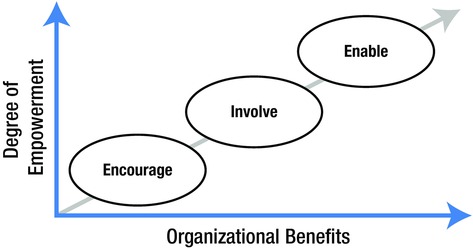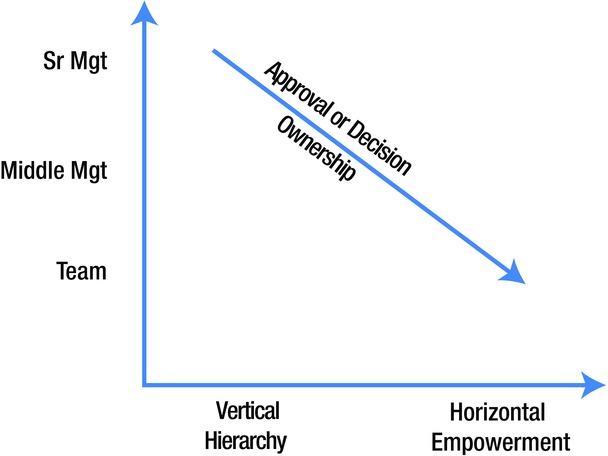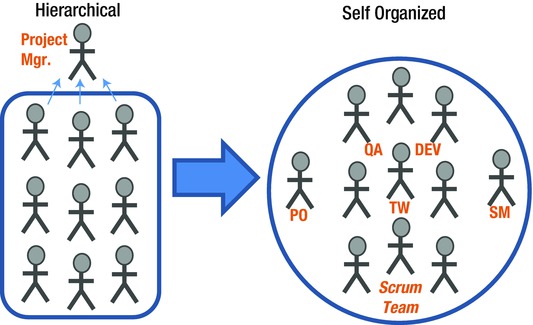Importance of Employee Engagement
As a society we know the best way to organize people is freeing them to organize themselves. Why should it be any different in business?
—Thomas Petzinger Jr.
Employees are critical assets for an organization. It is difficult to calculate their value for a variety of reasons. When employees are disengaged, they take long lunch hours and leave at the stroke of 5, not staying a moment longer than they have to. More important, they will not fully engage their minds to solve problems effectively. They do not contribute to and can even impede their company’s success. However, when they are engaged, they are crucial to the success of the company, bringing motivation, innovative ideas, and willingness to go the “extra mile” to get the work done. In this case, they can be a company’s greatest assets.
“Our employees are our most valuable assets” has become a standard cliché, but few companies back it up. Yet studies prove that higher engagement scores are statistically correlated with increased corporate performance. 1
One study found that of the forty best companies to work for, thirty-four included employee empowerment as part of their organizational strategy. 2 That study concluded that employee empowerment within the corporate culture is a “potential source for sustained superior financial performance.” Employee empowerment can lead to tangible organizational performance and thus should be taken seriously.
![]() Agile Pit Stop Employee empowerment isn’t just a warm-and-fuzzy benefit for the workers, but can lead to tangible performance and financial gain for an organization.
Agile Pit Stop Employee empowerment isn’t just a warm-and-fuzzy benefit for the workers, but can lead to tangible performance and financial gain for an organization.
The goal for your company is to make people matter and introduce real action that will improve employees’ engagement, ultimately leading to the financial benefit of the company.
Employee Empowerment
Everybody has heard the term empowerment in organizations—typically to hype up a new initiative so that employees will feel empowered. But it begs the question, “Shouldn’t employees already feel empowered?” Empowerment should be a core value of an organization’s strategy and not a trend that comes and goes. However, this is not the case for many organizations.
What exactly is employee empowerment? It is a framework that enables employees to control their own work and destiny. The brainpower and motivation of the talented folks who are hired are tremendous assets to a company. Jane Smith presents an employee empowerment model that includes three degrees of empowerment (Figure 5-1). 3 The first level encourages employees to play a more active role in their work. The second level asks employees to become more involved with improving the way things are done. The third level enables employees to make bigger and better decisions without having to engage upper management. The third level is key for an Agile culture.

Figure 5-1. Employee empowerment model with the goal of increasing empowerment
If management is earnest about applying a model like this, they can benefit in the following ways. They may see improvements in the quality of their product delivery, more innovation, increased productivity, and a gain in competitive edge.
Of course you want to empower your people. Yet somehow we have evolved into tribes and organizations where only management seems to know what is best. It is important to remember that management still has a role to play, and one of those roles is to get the most from their employees. This doesn’t mean making them work longer hours, but gaining their input and allowing them to make the decisions they need to control the work at their level.
If you think about it, employees go home and make decisions in their daily lives and manage thousands of dollars in their own personal budgets. But when they go to work, many of them have little discretion over even $100 of decision making and are forced to seek approval for the smallest things.
![]() Agile Pit Stop Why do employees who make decisions in their daily lives and manage thousands of dollars in their own personal budgets have so little discretion over the smallest things within their company?
Agile Pit Stop Why do employees who make decisions in their daily lives and manage thousands of dollars in their own personal budgets have so little discretion over the smallest things within their company?
An employee engagement practice allows teams to be empowered, self-organizing, and discretionary in making decisions at their level. Empowerment is enhanced when an adaptive framework like Agile is applied, which advocates a team-based model. If the team feels truly empowered and is allowed to self-organize, they will naturally increase their productivity because they own the work and the decisions to guide their work lives.
Self-Organizing Teams
So what does self-organizing team really mean? Diana Larsen writes:
When we say an Agile team is self-organizing, we mean that a group of peers has assembled for the purpose of bringing a software development project to completion using one or more of the Agile methodologies. The team members share a goal and a common belief that their work is interdependent and collaboration is the best way to accomplish their goal. 4
Attributes of self-organizing teams are that employees reduce their dependency on management and increase ownership of the work. This includes increasing team accountability and responsibility. A cultural shift involves pushing down the level of decisions to the lowest possible level—that is, reducing the need for numerous chains of approvals and decisions—can be a big change for most organizations. Changing the culture from a hierarchical command-and-control model to a more horizontal or team empowerment model (Figure 5-2) is unsettling.

Figure 5-2. Cultural shift involves pushing down the level of decisions to the lowest possible level at which the most knowledge exists to make the best decision
The primary benefit of self-organizing teams is that employees feel they own the work, tend to have more passion in their work, and then are much more likely to invest more of their time and energy. The implication is that the company may gain the benefit of stronger employee commitment and performance, leading to potential superior financial performance.
Consider the example of renting an apartment versus owning a home. When you rent an apartment, you may respect the property, but you are probably unwilling to improve the apartment very much because you know you don’t own it and thus have much less investment and attachment to the place. In other words, you are less likely to put your heart and soul into the apartment. It is just a temporary place to live. Now imagine that you own a home. You will not only respect the property, you will take much better care of it and are willing to invest time and money to improve it because you feel the pride of ownership. Not only are you more willing to invest in the home, you will be willing to protect and defend it. There may be passion in your drive to make the home as good as it can be. You are much more likely to place your heart and soul into maintaining and improving the home because of this sense of ownership.
This same premise holds true with our work life. If you don’t feel that you own the work and the decisions therein, you do just the minimum. However, if you feel you have ownership, you are willing to invest more time and energy into the work. It is particularly important for senior management to understand the significance of this concept.
Evidence of Self-Organizing
What do self-organizing teams look like? The following are some demonstrable attributes of a self-organizing team.
- Decision making: Team members make their own decisions about their work. Who better to make decisions than those who have the details?
- Sizing work: Team members size or estimate their own work. Who better to size the work than the people who work on the product and know its complexity?
- Team spirit: Team members have a strong willingness to cooperate and know that unless all succeed in their part, none succeed in the whole.
- Common goals: Team members feel they are coming together to achieve a common purpose through release goals, sprint goals, and team goals.
- Trust: Team members value people relationships and share information (including bad news) without fear of retribution or of the information being used against them.
- Transparency: Team members willingly share information to help other members make progress and better decisions. There is similar transparency between management and team members.
- Communication: Team members willingly communicate the latest progress and challenges, gaining clarity and fostering teamwork.
- Collaboration: Team members realize that the ability to bounce ideas off each other leads to better solutions and efficiencies in work processes.
- Assertiveness: Team members feel ownership, are motivated, are willing to pull work for themselves, and do not wait idly for someone else to assign work.
- Iterative learning: Team members understand that there is a continuous acquisition of knowledge with opportunities to improve as the product is being built.
- Collective commitment: Team members make a conscious effort to mutually commit to the work in a time-boxed manner and then progressively work to achieve that commitment.
When applied with integrity, these attributes will make any team or organization effective. If you strive for these elements, then it is important for management to model this behavior as well if they wish their teams to do the same.
For Scrum to work, the team has to deeply and viscerally understand collective commitment and self-organization. Scrum’s theory, practices, and rules are easy to grasp intellectually. But until a group of individuals has made a collective commitment to deliver something tangible in a fixed amount of time, those individuals probably don’t get Scrum. 5
Another form of evidence of self-organizing from an agile perspective is reorganizing from functional groups into Agile Teams. For example, Scrum teams are designed so that they remove hierarchy, leading to a flatter organization, and are designed to gain collective commitment. To do this typically requires a reorganization of resources. Figure 5-3 is an illustration of a reorganization from a hierarchical structure to a self-organized Agile Team structure.

Figure 5-3. Moving from hierarchical to self-organized teams requires a reorganization
Notice how this involves moving away from a single point of leadership to a flat team model in which everyone is a leader when it is appropriate and no one person tells others what to do.
Stepping Up
Agile entails a radical change not just to the culture of management but also to the culture of those in engineering. There is a strong expectation that management will step back and allow the Agile Team to be self-organized. On the engineering side, there is an expectation that they need to step up, communicate more, and be more assertive. This can be challenging. Whereas there is a lot of focus on getting management to step back, there isn’t enough focus on getting Agile Team members to step up.
Engineers tend to be introverts, so the notion of being assertive—let alone confrontational—can be uncomfortable. Often Scrum Masters end up doing a lot of the policing to ensure agile practices are being executed well. The Scrum Master may be seen “nagging” late arrivals to meetings and must push people to speak up. However, it is not just the Scrum Master’s responsibility to be assertive; every team member must be willing. Remember, Agile is for everyone, and every team member should consider himself or herself a leader. Are you stepping up?
In a hierarchical world, projects are managed by directive. A hierarchy exists where decisions get made based not necessarily on full knowledge, experience, or information but on position. Often, decisions are made by a few folks and then shared with the team. Ultimately this establishes a culture in which people on the project team become timid, lack enthusiasm, and do not feel ownership in the work. If this culture has been embedded, it can take an even bigger effort to motivate more assertive and extroverted behavior.
![]() Agile Pit Stop Though there is focus on getting management to step back, there isn’t enough focus on getting team members to step up. Engineers tend to be introverts and may be used to getting instructions. Changing this culture may be more challenging than you think.
Agile Pit Stop Though there is focus on getting management to step back, there isn’t enough focus on getting team members to step up. Engineers tend to be introverts and may be used to getting instructions. Changing this culture may be more challenging than you think.
Then along comes Agile. When implemented correctly, the Agile mindset places a strong emphasis on a team’s self-organizing capabilities. There is an expectation of limited command-and-control from management. The teams are trusted to make decisions because they are much closer to the details and have experience in that area. Team members feel invested in the work to come because they have a say in the direction of the product.
However, transitioning to an Agile culture does not immediately gain the advantages that you desire. There must be a recognition that managers and some overly directive people need to step back. However, when they do so, the team members must step forward to fill the leadership gap. If you want to feel invested in the work, you must be willing to take the responsibility of owning the decisions (see Figure 5-4). Otherwise, those people who stepped back—management—will have an habitual tendency to step forward again to fill the vacuum.

Figure 5-4. Agile Team members must step up to accountability of the work as the management are stepping back
This is where being assertive and proactive attributes become important. Some engineers may come from a culture where they are relegated to getting instructions. They are not expected to be leaders. With Agile, it is now their job to become self-organized and empowered, become leaders, and take assertive steps forward. For many engineers, this can be difficult because it takes them out of their comfort zone. However, when people move out of their comfort zone is when growth happens. Many managers’ comfort zone is directing the work. We need them to step out and trust the team to direct the work, while the managers grow in their ability as coaches.
What does this mean in the Agile context? First, as you become part of an Agile project, you must truly internalize that employees are now equally part of the team and their thoughts, experience, and opinions matter. This does not happen overnight because the dynamics of getting to an Agile culture are challenging and take time. There will be those working against you, sabotaging the change to maintain the status quo. Make no mistake: it is up to you to step up and assertively empower yourself.
So the next time you don’t think you are appropriately involved on the project or you think you need permission to speak up, stop for a moment. Change your mindset and be assertive, step up, get involved, become a leader, and start owning the decisions and work. Agile provides that opportunity. It is your opportunity to take advantage of it.
Understanding Value-Added Work
A concept that is important for employees to understand as they begin to own their work is what is considered valuable work to the customer. Part of the Agile mindset is to bring the business closer to the engineering team. One aspect of this is to understand what working software the customer finds valuable.
From a customer perspective, value-added work (VAW) is functionality that they find valuable at the time and place of their need. This includes the effort and “done” criteria steps (such as designed, developed, versioned, built, and tested increments) that are directly related to building the features to produce working software. Applying a minimal viable product (MVP) approach can provide you with a good framework for prioritizing and rank ordering the valuable work the customer needs.
Employees are typically aware of the non–value-added work (NVAW) they are asked to do. NVAW can be as simple as functionality the customer does not find valuable, or it can be unnecessary steps in the process of building working software. Examples of NVAW include:
- administrative-related tasks
- education and training
- all-hands and staff meetings
- writing status report
- defect correction introduced by poor quality
- refactoring tasks
- unnecessary steps or approvals
![]() Agile Pit Stop NVAW (a.k.a. waste or muda) are effort that do not directly add value as perceived by the customer and may include unneeded functionality or unnecessary steps in a process of building working software.
Agile Pit Stop NVAW (a.k.a. waste or muda) are effort that do not directly add value as perceived by the customer and may include unneeded functionality or unnecessary steps in a process of building working software.
For a broader understanding of NVAW effort or waste, Mary and Tom Poppendieck provide a robust understanding from a lean software development perspective of the Seven Wastes of Software Development: 6
- partially done work
- extra processes (or extra steps)
- extra (unwanted) features
- time involved with task switching
- time spent waiting
- tracking down information or needing approvals
- time spent correcting defects
In lean thinking, this is known as waste or muda. We have come to accept NVAW because we have done things for so long, we haven’t reconsidered the value of the tasks and activities that we do and the process in which we work in quite some time. Although it may sound harsh and there is some internal value in this work at varying levels, the question becomes: where do you really want to spend your time, and is it a good idea to reduce the NVAW?
When applying an Agile and lean mindset, we need to consider the value of each task. Is the task being asked of the team considered value-added or non–value-added from a customer perspective? Sometimes folks have a hard time separating tasks into value and nonvalue because it highlights the nonvalued tasks. However, it really is important to understand your value-added and non–value-added breakdown so you can baseline the value level of the work and hopefully increase the value-added work over time (Figure 5-5).

Figure 5-5. Baselining VAW and NVAW from a customer perspective
![]() Agile Pit Stop It can be hard separating work into value-added and non–value-added because it can highlight the level of NVAW that is being done.
Agile Pit Stop It can be hard separating work into value-added and non–value-added because it can highlight the level of NVAW that is being done.
Another benefit of identifying VAW vs. NVAW is that when you are considering the velocity or productivity of teams in regard to building new functionality, the percentage of NVAW is a direct impediment to a team’s ability to build new functionality. In other words, it is not uncommon for management to think that employees are using a majority of their work week building new functionality when the reality is that only 50 percent may be spent doing so.
Customers and Employees Matter: Are We There Yet?
When a company has a strong focus on the customer and the employee, there is a strong potential for financial rewards. The Agile Vision to Incentive Differentiator (AVID) model presented in Chapter 3 may work for you. If your company’s business strategy includes objectives focusing on customer engagement and employee engagement, you can benefit from truly understanding what is most valuable to the customer and harness the brainpower of your employees. By adding the special ingredient of applying the Agile values and principles along with a continuous and adaptive framework (Scrum, XP, Kanban, etc.), there is the potential of incentives involving an increase in revenue for the company.
What were the perceived benefits obtained from implementing Agile? It is one thing to have certain reasons for moving to Agile, and quite another to see if the benefits are realized. Within the 2012 VersionOne survey on Agile, the results highlighted some benefits we are looking for. 7
- 90 percent of those surveyed felt that “ability to manage changing priorities” “got better” within their company.
- 85 percent of those surveyed felt that “increased productivity” “got better” within their company.
- 84 percent surveyed felt that “team morale” “got better” within their company.
These results bode well for Agile. However, this does not accidentally occur. Companies must include this into their business strategy to highlight that they take the notions of customers, employees, and Agile seriously. Maybe the vision where “customers and employees really matter” makes sense after all. The question is: how important is it to delight your customers by building customer value and harnessing the brainpower of your employees? While it is easy to reflexively say “very!,” the reality is that we get distracted by the day-to-day “administratium” of the company and forget our values. Ultimately your results will vary depending on the sincerity and commitment you have to customers, employees, and Agile.
1 Brian E. Becker, Mark A. Huselid, and Dave Ulrich, The HR Scorecard: Linking People, Strategy, and Performance (Harvard Business Review Press, 2001).
2 Darrol J. Stanley, “The Impact of Empowered Employees on Corporate Value”: Graziadio Business Review, 8, no. 1 (2005).
3 Jane Smith, Empowering People (Kogan Page, 2000).
4 Diana Larsen and Industrial Logic, “Team Agility: Exploring Self-Organizing Software Development Teams,” Agile Times Newsletter (2004).
5 Ken Schwaber, Agile Project Management with Scrum (Microsoft Press, 2004).
6 Mary Poppendieck and Tom Poppendieck, Lean Software Development: An Agile Toolkit (Addison-Wesley Professional, 2003).
7 VersionOne, “7th Annual State of Agile Development Survey,” November 2012, http://www.versionone.com/pdf/7th-Annual-State-of-Agile-Development-Survey.pdf.

